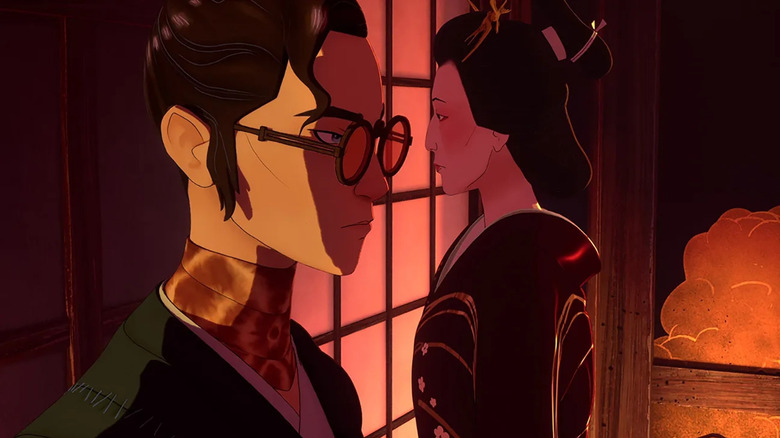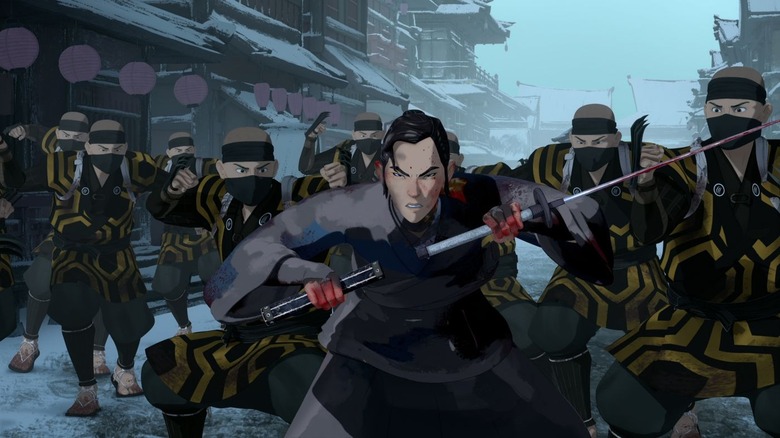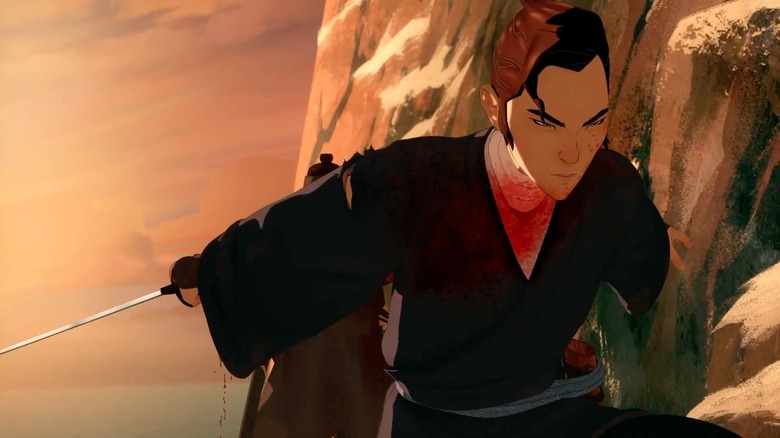Blue Eye Samurai Blends Lady Snowblood Revenge Action With Eye-Popping Animation
(Welcome to Animation Celebration, a recurring feature where we explore the limitless possibilities of animation as a medium. In this edition: "Blue Eye Samurai.")
When's the last time you watched something and felt compelled to fist pump at the TV? For most, it was probably a favorite sports team winning the big game. But for me, it was the first episode of the new Netflix series, "Blue Eye Samurai." During the premiere of the show (attended by /Film's Jenna Bush-Henderson), it was revealed that the seed for the new animated series from Michael Green ("Logan," "Blade Runner 2049) and Amber Noizumi was first planted about 15 years ago after the show creators welcomed the birth of their daughter. She was born with blue eyes, and Noizumi, who is half-Japanese, found herself wondering, "Why am I so excited that my daughter has blue eyes? What's the big deal about that? And why am I so excited that I have a baby who looks more white?"
After Noizumi interrogated her internalized feelings about her child, she concocted the story of "Blue Eye Samurai," an animated revenge saga that feels like the spiritual successor to Toshiya Fujita's "Lady Snowblood" series. The show tells the story of Mizu ("Pen15" star Maya Erskine), a child born out of sexual violence enacted by one of the four white men in Japan during the Edo period when Japan's borders were closed to outsiders. Her distinct blue eyes have marked her as an outsider, a "creature of shame," as she calls herself, and has chosen the path of revenge against her father. However, as women are required to live out lives of practicality, Mizu must hide both her gender and eye color as she hunts down her possible targets. It's bloody, brutal, beautiful, and one of the best new animated shows of 2023.
Sketching stunts
Amber Noizumi and Michael Green both cut their teeth in live-action, and based on what they told Animation Magazine, their first foray into the animation medium came with a bit of a learning curve. "We were like, 'Yeah, we can go to Kyoto, and go to Edo, and go to this city, and build this castle, and [the animators] just have to draw it. That's not a big deal, right?' And only when we began to talk to people who knew things were they like, 'Oh, no, that's a big deal! These things cost time and they cost money,'" said Noizumi. This meant the creators leaned heavily on supervising director Jane Wu, who has been involved in both animation and live-action, like "Teenage Mutant Ninja Turtles: Out of the Shadows" and "Captain America: Civil War."
The action-packed movement of the series is emphasized by the stunning animation style, which incorporates traditional 2D animation with 3D models. Even the moments that are completely computer-generated have a hand-drawn feel. "We just kept saying, 'Let's not do the thing where we have beautiful concept art and throw it away," said Green. "Let's make it look like the concept art." The intention paid off, because "Blue Eye Samurai" is equal parts graphically gory and drop-dead gorgeous. So much so that the showrunners gave the animators a content warning before joining the team, knowing that drawing severed limbs and blood fountains might not be for everyone.
Mizu obliterates opponents with ease, slicing and dicing enemies like an Iron Chef in a chopping challenge and using knocked-out teeth like bullets. "Blue Eye Samurai" isn't an anime by definition, but clearly draws inspiration from some of the greats while emulating the trademarks of samurai and exploitation cinema of yesteryear.
From homage to heroic
While "Blue Eye Samurai" is staunchly Mizu's story, she's also joined by a delightful cast to balance out her vengeance. There's Ringo (Masi Oka), a soba maker brimming with optimism and determined to become a samurai in his own right, refusing to let the fact he doesn't have hands hold him back. There's also Taigen (Darren Barnet), a self-made samurai who has known Mizu since they were very young, and Akemi (Brenda Song), a daughter of a lord who wants out of the predetermined life her father has arranged for her. The three supporting characters' individual arcs all weave in and out of one another but help to paint a more complex picture of Japan during the Edo period.
The series is also dripping with traditional Japanese practices, like one episode that utilizes bunraku puppets to help tell the story. As a work of historical fiction, "Blue Eye Samurai" never forgets the history of the time period or people. It's an animated jidaigeki in the best ways possible, with a final product that would make Akira Kurosawa proud. At the same time, "Blue Eye Samurai" is not afraid to blatantly reference Western media inspired by Asian cinema — "Kill Bill" and Westerns, especially. Despite the seemingly paint-by-numbers revenge tale, "Blue Eye Samurai" is anything but predictable. As the story unfolds, we're given a more intimate look at Mizu's backstory, and Maya Erskine's performance is one for the ages.
With only eight episodes, "Blue Eye Samurai" is an easily digestible watch, but with an addictive story that you'll have to fight yourself from binging.


